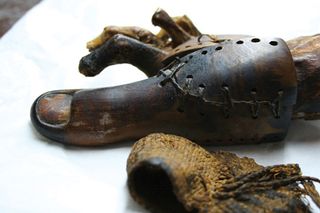Egyptian Discoveries
ig66-king-tutankhamun-09.jpg

The discovery of jars of wine in King Tuts tomb prompted a team of Spanish scientists to try and determine if the boy king preferred red or white wine. An analysis of residues in 2005 revealed that the jars contained syringic acid, which implied that the wine was made with red grapes.
ig66-wood-toe-09.jpg

Archeologists explored a tomb near Thebes in 2005 and discovered an artificial big toe attached to the foot of a mummy. The fake body part could prove to be the earliest working prosthetic body part to date.
ig66-ap-baby-mummy-09.jpg

The mummified remains of an Egyptian 6-year-old sat in the attic of its owners before being donated to the St. Louis Science Center in 1985. Researchers at the center have used CT scan technology to help unravel the mystery of its origins.
Sign up for the Live Science daily newsletter now
Get the world’s most fascinating discoveries delivered straight to your inbox.












